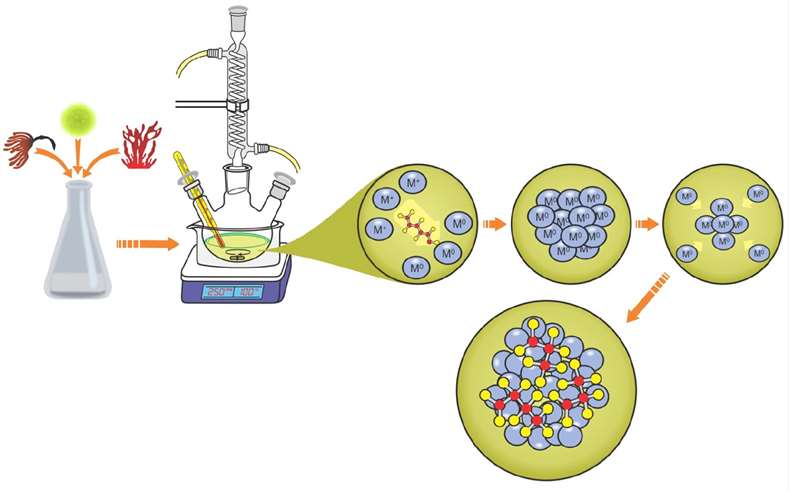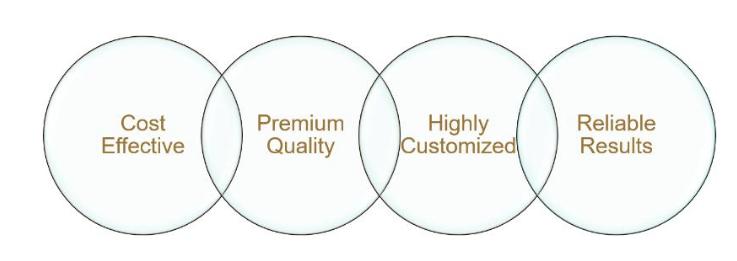Metal Nanoparticles Biosynthesis Services from Algae
Among a variety of environmentally friendly and energy-efficient methods for the biological synthesis of nanoparticles, the synthesis of metal nanoparticles by algae is a highly efficient method.
As a researcher and developer of algal bioproduction, Lifeasible has the professional equipment and scientific teams that can undertake quality metal nanoparticle biosynthesis services from algae.
Introduction to Nanoparticles
Nanotechnology is a new type of technological engineering whose products are nanoparticles (NPs) or nanomaterials (NMs), within 10-9 m in size. Because of their large surface area to volume ratio, their ability to easily interact with other particles, and several other unique properties, nanoparticles are widely used in electronic, cosmetic, biomedical, and biotechnological applications. NPs are classified into different types according to the shape and size of the material, phase composition, and properties.
| Classified by Shape and Dimension | Zero-dimension | Quantum dots, coreshell, onion, hollow spheres |
| 1D | Films, coating, multilayer | |
| 2D | Tubes, fibers, wires, platelets | |
| 3D | Particles, quantum dots, hollow sphere | |
| Classified by Phase Composition | Single-phase Solids | Crystalline, amorphous particles and layers |
| Multi-phase System | Colloids, aerogels, ferrofluids | |
| Classified by Nature of Material | Pure Metals | Ag, Au, Cu, Fe, Ni, Co |
| Metallic Oxides | ZnO, CuO, TiO2, Fe3O4, CrO2 | |
| Metallic Chalcogenides | PbS, ZnS, CdS, ZnSe, CdTe, HgS, CuInSe | |
| Bimetallic | Ag-Au, Zn-Ag, Pt-Ni, Co-Mo | |
| Organic | CNT, Fullerene, Graphene Oxide |
Biosynthesis of Nanoparticles from Algae
It is well known that algae can over-accumulate heavy metal ions and have the special capacity to remodel them into a more plastic form. Due to these attractive properties, algae have been foreseen as model organisms for the fabrication of bio-nanomaterials.
According to the available reports, algae-mediated synthesis of NMs consists of the preparation of algal extract, metal precursor solution, and incubation of algal extract with metal precursor solution.
 Fig.2 Mechanism of synthesis of nanomaterials from algae. (Khanna, P., et al., 2019, Journal of microbiological methods)
Fig.2 Mechanism of synthesis of nanomaterials from algae. (Khanna, P., et al., 2019, Journal of microbiological methods)
Intracellular Synthesis of Nanoparticles - The intracellular synthesis of nanoparticles in algae requires no pretreatment of microalgae as the process relies on metabolic pathways that may be responsible for the synthesis, such as photosynthesis, respiration, and nitrogen fixation.
Extracellular Synthesis of Nanoparticles - Extracellular synthesis of nanoparticles occurs outside the cell and is supported mainly by exudates from cellular metabolism, including metabolites, ions, pigments, various enzymes, and other substances such as DNA, RNA, hormones, antioxidants, and lipids.
Advantages of Algae Production of Nanoparticles
Algae are one of the most primitive and influential biological entities. Being rich in bioactive compounds, they are considered an attractive platform and are thought to produce metal NPs. More than one hundred different micro- and macroalgae have been reported that exhibit the ability to tailor NPs intracellularly and extracellularly that can be recovered in downstream processing.
Some of the practical properties of algae make them outstanding "nano-biofactories", such as faster doubling time, easily scalable and well-established systems, easy cell disruption, easy harvesting, low-cost large-scale synthesis, and accelerated nucleation and crystal growth due to the presence of negative charges on the cell surface.
Our Services
With extensive experience in the production of algae nanoparticles, Lifeasible provides quality metal nanoparticle biosynthesis services from algae and consulting services to facilitate the research projects of our customers worldwide.
Through the NPs biosynthesis process, a number of factors exhibit significant effects on nanoparticle production, such as extract concentration, contact time, pH, and temperature. Depending on the algal species and the types of nanoparticles, these parameters are adjusted to result in smaller sizes and higher yields of NPs.
- Extract Concentration - The higher the concentration of extracts, the smaller the average size of NPs.
- Contact Time - The synthesis of NPs is more rapid with the gradual increase of contact time.
- pH - At higher pH values, the diameters of the formed NPs are smaller.
- Temperature - The increase in temperature, the key parameter, increases the reaction rate and leads to the formation of smaller NPs.
Why Choose Us

As a pioneer in the research of algal cell factories, Lifeasible is able to provide high-yield and high-quality production of nanoparticles from a wide range of algal strains to facilitate your project development. Please contact us for more information.
Reference
- Khanna, P., Kaur, A., & Goyal, D. (2019). Algae-based metallic nanoparticles: Synthesis, characterization and applications. Journal of microbiological methods, 163, 105656.
Our services are for research use only and not for any clinical use.